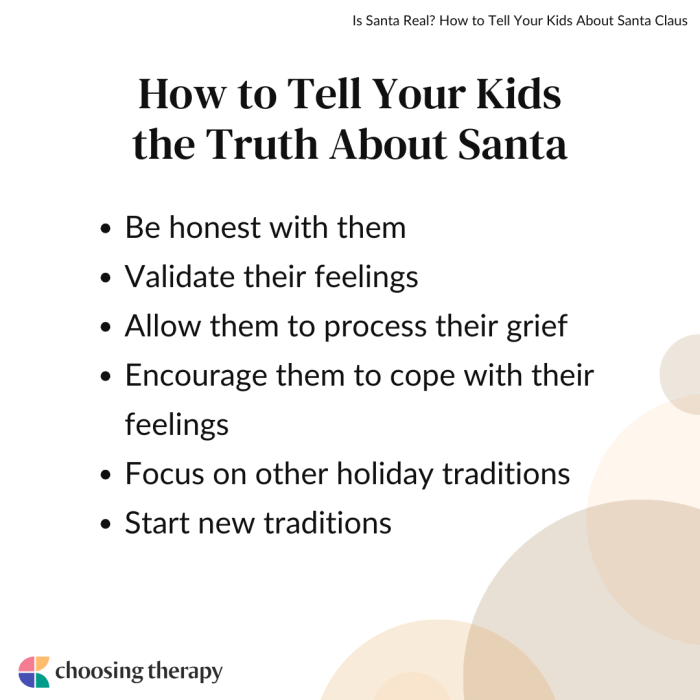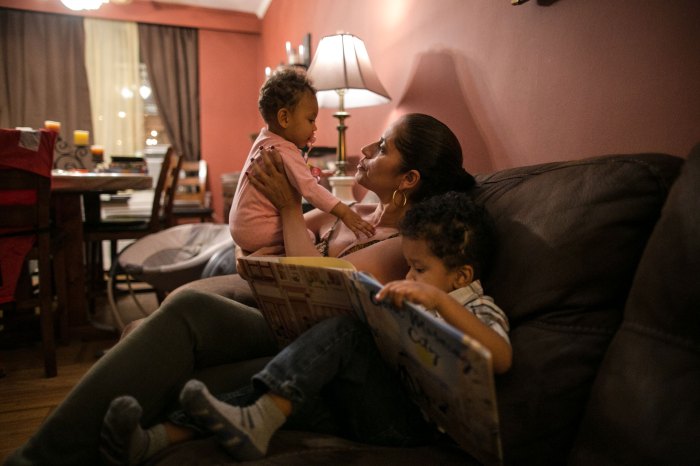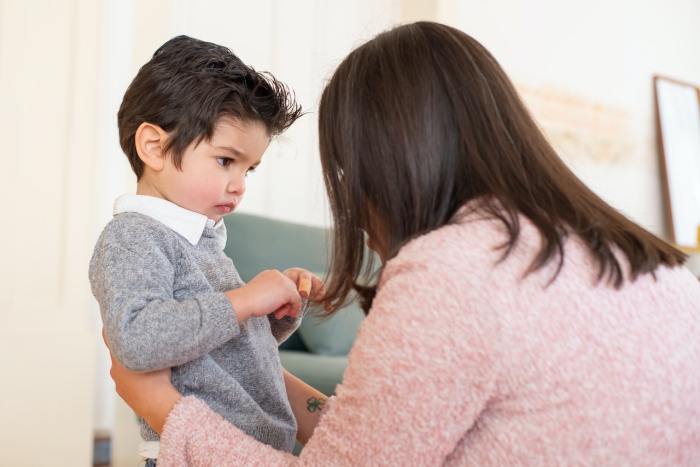How to tell kids about Santa is a crucial topic, especially for parents and guardians. It’s all about navigating the delicate balance between maintaining the magic and honesty. This guide dives deep into different approaches, from understanding the child’s age and developmental stage to crafting a compelling narrative that respects their curiosity.
Whether you’re dealing with a curious 3-year-old or a skeptical 9-year-old, this guide will equip you with the tools to handle the conversation with grace and confidence. It covers everything from crafting the perfect Santa story to addressing potential concerns and managing family dynamics.
Understanding the Child’s Age and Development

Navigating the delicate conversation about Santa with children requires a nuanced approach, tailored to their individual developmental stages and cognitive abilities. This section will Artikel different strategies for explaining the concept to children of various ages, emphasizing the importance of open communication and building trust.
Age-Appropriate Explanations
Children at different ages perceive and process information differently. Understanding these developmental nuances allows for a more effective and comfortable conversation.
- Ages 3-5: Children in this age group are still developing their understanding of symbolic thinking and fantasy. Focus on the magical and fun aspects of Christmas. Emphasize the spirit of giving, the joy of the season, and the excitement of receiving presents. Avoid overly complex explanations about Santa’s origins or logistics. A simple story about Santa’s visit and the joy it brings can suffice.
For example, “Santa is a special visitor who brings gifts to good children on Christmas Eve. He brings lots of happiness to the whole family.” Be prepared to answer questions about Santa’s appearance or how he fits down the chimney with simple, imaginative answers.
- Ages 6-8: Children in this age group are beginning to develop critical thinking skills and question the world around them. They may start to ask more direct questions about Santa’s existence. A slightly more detailed explanation is appropriate, while still maintaining a touch of magic. Mention the traditions associated with Santa and how they contribute to the festive atmosphere.
For example, “Santa Claus is a beloved figure in our Christmas traditions. He represents the spirit of giving and joy, and the excitement of receiving presents is a fun part of the holiday season. We all participate in making this magical experience happen together.” It’s important to acknowledge the child’s growing sense of logic without taking away the wonder.
- Ages 9-11: Children in this age group are developing a more sophisticated understanding of reality and are likely to question Santa’s existence directly. This is an opportunity to discuss the importance of traditions, the spirit of generosity, and the joy of the holidays. Acknowledge that their questions are valid and provide honest, age-appropriate explanations about the historical development of Santa Claus.
Acknowledge that different people have different beliefs and that their faith is a personal journey. For example, “Santa is a symbol of the spirit of Christmas. Many cultures have their own figures representing the holiday season. The myth of Santa Claus has evolved over time, incorporating elements of earlier traditions and becoming a cultural icon associated with the magic of Christmas.” Encourage critical thinking by presenting different perspectives on the topic.
Tailoring the Explanation
The explanation should be tailored to the child’s individual understanding and maturity level. It is crucial to listen attentively to the child’s questions and responses, adjusting the explanation accordingly.
Identifying Confusion and Discomfort
Pay close attention to nonverbal cues, such as changes in facial expression, body language, or tone of voice. These can indicate confusion or discomfort.
Open-Ended Questions
Employ open-ended questions to encourage the child to express their thoughts and feelings. Examples include:
- “What do you think about Santa?”
- “What makes Christmas special for you?”
- “What questions do you have about Santa?”
- “How do you feel about learning more about Santa?”
Building Trust and Open Communication
Building trust is essential to foster open communication about the topic. Create a safe and supportive environment where the child feels comfortable asking questions and expressing their thoughts and feelings without judgment.
Crafting a Narrative About Santa
Weaving a compelling narrative about Santa Claus for children requires a delicate balance between tradition and reality. It’s about fostering wonder and imagination while subtly acknowledging the fantastical nature of the story. The key is to make the narrative feel authentic and relevant to the child’s understanding, avoiding the pitfalls of outright denial or overly complex explanations.Explaining Santa’s origins and role involves creating a narrative that resonates with a child’s innate sense of magic and wonder.
It’s not about debunking the myth, but about re-framing it within a context that’s both enjoyable and meaningful. This approach allows children to appreciate the spirit of the holiday season while maintaining a healthy respect for the truth.
Designing a Narrative Resonating with Children
A strong narrative emphasizes the spirit of giving and the joy of the season. Focus on Santa’s role as a symbol of generosity, kindness, and the magic of believing in something wonderful. This narrative can be tailored to different age groups, progressing from simpler explanations to more nuanced understandings as the child matures. Children often connect with stories that feature relatable characters and situations.
Explaining Magic and Wonder Realistically
Children naturally gravitate towards concepts of magic and wonder. Rather than dismissing these as mere illusions, framing them as aspects of imagination and the power of belief can be more engaging. Focus on the emotional and psychological aspects of the story, highlighting how Santa’s presence can inspire kindness and generosity in children. Emphasize the importance of values such as sharing, caring, and helping others.
Alternative Explanations for Different Cultures and Contexts
Many cultures have their own unique traditions surrounding gift-giving and the holiday season. Recognizing and respecting these differences is essential. For example, in some cultures, the focus is on family gatherings and traditions rather than a single figure like Santa. A narrative can be adapted to reflect these different perspectives, emphasizing the shared values of community, love, and celebration.
This will broaden the child’s understanding of the world and foster respect for cultural diversity.
Examples of Alternative Explanations
- In some Asian cultures, the focus is on the spirit of family reunion and celebration, and the exchange of gifts is more about strengthening familial bonds. A narrative focusing on family traditions and the joy of togetherness could be more relevant.
- In cultures with a strong emphasis on community service, a narrative focusing on the spirit of giving and the importance of helping others can be more engaging. The focus can shift from material gifts to acts of kindness and generosity.
Comparing and Contrasting Cultural Perspectives on Gift-Giving
| Culture | Focus of Gift-Giving | Role of Santa/Equivalent Figure |
|---|---|---|
| Western Cultures | Material gifts | Santa Claus as the bringer of gifts |
| Asian Cultures | Strengthening familial bonds | Family members/celebratory traditions |
| Some Latin American Cultures | Sharing with community | Folklore figures representing goodwill and community spirit |
Different cultures have distinct approaches to gift-giving, emphasizing different values. Comparing and contrasting these perspectives can help children understand the diversity of traditions and the shared human desire to celebrate and connect.
A Structured Approach to Introducing Santa
A structured approach involves gradual introduction of the concept, beginning with the spirit of giving and the joy of the season. Focus on the positive aspects of the holiday and the importance of helping others. Gradually introduce the figure of Santa, emphasizing his symbolic role as a representation of generosity and belief. Avoid overwhelming children with excessive detail or pressure to believe.
It is important to nurture a sense of wonder and encourage a spirit of giving.
Addressing Potential Concerns and Doubts
Navigating the delicate dance of truth and wonder can be tricky when discussing Santa with children. Open communication, combined with a thoughtful approach to potential questions and concerns, is key to maintaining a positive experience and fostering a healthy sense of imagination. Anticipating potential challenges allows parents to proactively address them, ensuring a smooth and enjoyable transition for both the child and the family.
Common Questions About Santa
Children’s curiosity often blossoms into a whirlwind of questions about Santa’s existence and the mechanics of gift delivery. Preparing for these inquiries beforehand will ease the process and allow for a more natural conversation.
- Children often question Santa’s existence, wondering if he’s real. Addressing this directly and honestly, while still maintaining the magic, is crucial.
- Logistics of gift delivery, like how Santa travels the world in one night, are frequently questioned. Offering explanations that respect the child’s developing understanding of the world is essential.
- The number of children Santa visits globally and how he manages to deliver gifts to each one are questions that need careful consideration.
- The role of helpers and the magic of the holiday season are also frequently questioned by children. Acknowledging these aspects can keep the wonder alive.
- Children may question the origin of the gifts and how they appear under the tree, prompting discussions about the generosity and love associated with the holiday season.
Addressing Concerns About Santa’s Existence
Maintaining a positive and supportive environment is crucial. Instead of directly dismissing a child’s doubts, acknowledge their questions with empathy. Explain that many people enjoy the magic of believing in Santa, even if he isn’t a physically real person. Emphasize the importance of the spirit of giving, the joy of sharing, and the warmth of the holiday season.
Reinforce that believing in Santa is about enjoying the special time of year and the wonderful traditions associated with it.
Responding to Logistics Questions
Explain that the magic of Santa is about the spirit of generosity and wonder, not the precise mechanics of his actions. Frame the stories around the idea that Santa represents kindness, compassion, and the desire to spread joy. Avoid giving overly detailed explanations that could dismantle the child’s belief too abruptly. Explain that the magic of Santa is about believing in the spirit and joy of the holidays.
Addressing Potential Anxieties
Recognizing that children might experience anxiety about the possibility of Santa not being real is important. Approach the discussion with empathy and reassurance. Explain that it’s normal to have questions and to feel a mix of emotions as they grow. Ensure them that their feelings are valid, and reassure them that the spirit of the holidays, such as the warmth of family, generosity, and joy, remains regardless of Santa’s existence.
Encouraging Critical Thinking
Guide children toward critical thinking by emphasizing the importance of imagination and the joy of storytelling. Encourage them to consider the broader meaning of Santa, which is the celebration of family, generosity, and the magic of the holidays. This shift in perspective helps them understand that Santa isn’t just a person but a symbol of the spirit of the holidays.
For example, they can explore different stories about Santa in various cultures, noting how they share similar themes of giving and joy.
Maintaining a Supportive Environment
Creating a positive and supportive environment fosters trust and encourages open communication. Emphasize that it’s okay to have questions and that exploring these questions together is a way to strengthen the bond between parents and children. Celebrate the child’s curiosity and encourage them to express their thoughts and feelings. Reassure them that their curiosity is a positive aspect of their development.
Maintaining the Magic (or Transitioning): How To Tell Kids About Santa
Navigating the transition from believing in Santa to understanding the reality behind the festive cheer can be a delicate dance. This phase requires sensitivity, empathy, and a proactive approach to help children navigate this shift with grace and continued joy. The goal isn’t to dismantle the magic entirely but to help them embrace a more nuanced and mature understanding of the holiday season.This crucial period often involves a gradual unveiling of the truth, rather than a sudden revelation.
Children process information at different paces, and respecting their individual journeys is paramount. By focusing on the underlying spirit of giving, generosity, and family connection, you can help them maintain the enchantment of the holidays while acknowledging the truth.
Gradual Transition Strategies
Children often have different levels of understanding and maturity. A gradual approach allows for the child’s development to dictate the pace. Starting with subtle hints, like mentioning the work of volunteers or the joy of family time, allows them to integrate new information organically. This approach is not about hiding the truth but about introducing it in a way that is both age-appropriate and supportive of their emotional well-being.
Handling Disappointment and Sadness
Children may experience sadness or disappointment when the truth about Santa is revealed. Acknowledging and validating these feelings is crucial. Emphasize that it’s okay to feel a range of emotions. Explain that the belief in Santa was a beautiful part of the experience, but it doesn’t diminish the importance of the holiday itself. Reinforcing the significance of family traditions and the spirit of giving can help ease the transition.
Maintaining Holiday Magic
Maintaining the magic of the holiday season isn’t about clinging to a falsehood. It’s about fostering the spirit of wonder and excitement. Emphasize the joy of giving, the warmth of family gatherings, and the anticipation of special moments. Encourage creative activities like making homemade gifts, writing letters to loved ones, or decorating cookies together. These activities will reinforce the positive aspects of the holiday season, regardless of their understanding of Santa.
Encourage exploration of the reasons behind the traditions.
Alternative Ways to Maintain Wonder, How to tell kids about santa
Instead of Santa, introduce the idea of the spirit of Christmas as a guiding force. This can involve focusing on kindness, generosity, and the magic of togetherness. Talk about the stories of giving and sharing that have been passed down through generations. Involve children in activities like making cards for hospitalized children or volunteering at a local charity.
These actions help solidify the underlying spirit of the holiday season, emphasizing compassion and connection rather than a specific figure.
Addressing Child Reactions
| Child’s Reaction | Approach | Possible Responses |
|---|---|---|
| Curious and inquisitive | Open-ended questions, encourage discussion | “What do you think about Santa?” |
| Skeptical | Direct and honest explanation | “Santa is a fun story to help us celebrate Christmas.” |
| Sad or disappointed | Empathy, reassurance | “It’s okay to feel sad, it’s a change.” |
Managing Family Dynamics

Navigating the Santa conversation with multiple generations and personalities can feel tricky. Family dynamics, especially when it comes to traditions, can be complex. This section explores how to navigate conversations about Santa with various family members, ensuring a consistent message and avoiding potential conflicts. It’s crucial to approach this with empathy and understanding for everyone’s perspectives.Open communication is key to maintaining a harmonious family environment during this transition.
Different families approach the Santa myth differently, and understanding these varied approaches can help you determine the best course of action for your own family.
Communicating with Different Family Members
Effective communication with different family members requires tailored approaches. Parents, grandparents, and siblings each have unique perspectives and levels of involvement in the Santa narrative. Acknowledging these differences is essential for a smooth transition.
- Parents: Open and honest conversations with parents about the evolving Santa narrative are crucial. Acknowledging their own childhood experiences and feelings about Santa can help them better understand and support the transition for their children.
- Grandparents: Grandparents often hold strong sentimental attachments to traditions. Involving them in the process, perhaps by allowing them to participate in certain aspects of the Santa narrative, while gently explaining the changing understanding of the story, can help bridge the generational gap.
- Siblings: Siblings can be a source of both support and potential conflict. Establishing clear communication channels and expectations regarding the Santa narrative can help ensure consistency in messaging across all family members.
Ensuring Consistency Across Family Units
Consistency in the Santa narrative is vital to avoid confusion and potential disappointment. Different family members often have varying levels of awareness and engagement with the story.
- Shared Understanding: Establish a shared understanding of the Santa narrative within the family unit. This includes discussing the age-appropriateness of the narrative and deciding together how the story will evolve as the child grows.
- Joint Decisions: Jointly create and agree on the boundaries and details of the Santa story. This can involve discussing the child’s comprehension level and how the family will navigate the transition.
- Regular Check-ins: Schedule regular check-ins with all family members to ensure everyone is on the same page. This will help to address any potential concerns or misunderstandings.
Resolving Disagreements
Disagreements are inevitable when dealing with a sensitive topic like the Santa myth. Having strategies in place to address these conflicts is essential.
- Active Listening: Actively listen to the concerns and perspectives of each family member. Emphasize understanding different viewpoints and motivations.
- Compromise: Explore areas of compromise and find solutions that satisfy everyone involved. This might include creating a specific narrative that satisfies different generations.
- Open Dialogue: Maintain an open and honest dialogue with family members. This is crucial to address any disagreements proactively.
Comparative Approaches
Families often adopt different approaches to discussing Santa. Understanding these approaches can help you determine the best approach for your family.
| Family Approach | Description |
|---|---|
| Gradual Transition | This approach involves gradually shifting the focus from the literal Santa to the spirit of giving and joy. |
| Direct Disclosure | This approach involves openly discussing the Santa myth with children. |
| Maintaining the Illusion | This approach involves maintaining the illusion of Santa as long as possible, allowing the child to experience the magic of the holiday. |
Enhancing the Experience
Weaving the magic of the holidays doesn’t hinge solely on Santa’s presence. It’s about creating a spirit of togetherness, kindness, and shared experiences that resonate long after the decorations come down. Focus on fostering these values, and the holiday season will hold a profound and lasting impact.The holiday season offers a wonderful opportunity to instill important values in children.
By shifting the focus from material gifts to meaningful interactions and acts of service, we can create memories that emphasize the true essence of the season. This approach cultivates a sense of gratitude, compassion, and community spirit, enriching the holiday experience for everyone involved.
Incorporating Activities that Enhance the Holiday Spirit
The spirit of the holidays extends beyond the material. Creating shared experiences, both within the family and the community, strengthens bonds and fosters a sense of belonging. These activities often leave a more lasting impression than any gift.
- Family Volunteering: Organizing a family volunteer outing to a local soup kitchen, animal shelter, or food bank allows children to experience firsthand the impact of their actions. It cultivates empathy and a sense of responsibility for the community. For example, a family could spend an afternoon sorting donations, preparing meals, or playing with the shelter animals, fostering a deeper understanding of others’ needs.
- Community Events: Participating in community events like holiday parades, tree lightings, or carol sing-alongs allows children to connect with their neighbors and participate in a shared cultural experience. These events create a sense of community spirit and encourage social interaction.
- Creating Handmade Gifts: Encourage children to make gifts for family members and friends. This fosters creativity, resourcefulness, and the joy of giving. This activity teaches children about the value of personal touch and effort. For instance, a child could create a heartfelt card, a knitted scarf, or a hand-painted picture, fostering appreciation for the value of their labor.
- Holiday Crafts and Decorations: Engaging in craft projects together, such as decorating cookies, making paper chains, or creating holiday cards, fosters creativity and encourages collaboration. These activities allow for the creation of beautiful and lasting memories. For instance, families could paint ornaments together or design window displays that reflect the holiday spirit.
Activities that Don’t Center Around Santa
Shifting the focus from Santa to the holiday spirit itself allows for a wider range of experiences and activities. These activities strengthen family bonds, build community connections, and reinforce valuable life lessons.
- Holiday Story Time: Reading holiday stories together, both classic and contemporary, fosters a shared experience and promotes imagination. This activity creates an atmosphere of joy and togetherness.
- Holiday Meals and Traditions: Sharing a special holiday meal, and maintaining family traditions, strengthens family bonds and creates lasting memories. These traditions can involve creating a new tradition or revisiting an old one. For instance, a family could try a new holiday recipe or gather to watch a classic holiday film together.
- Outdoor Activities: Engaging in outdoor activities, such as sledding, ice skating, or building snowmen, provides opportunities for physical activity, fresh air, and shared experiences. This can foster a deeper appreciation for nature and create lasting memories.
Ending Remarks
In conclusion, telling kids about Santa is a sensitive subject that requires careful consideration and preparation. By understanding your child’s individual needs and tailoring your approach accordingly, you can create a positive and memorable experience. Remember, the goal is to foster open communication, maintain the magic, and help them understand the spirit of the holidays. So, take a deep breath, and let’s get started!
FAQ Resource
What if my kid already suspects Santa isn’t real?
Acknowledge their suspicion with honesty and respect. Explain that Santa is a fun story to help us celebrate Christmas. Avoid defensiveness; instead, focus on the positive aspects of the holiday season.
How can I handle disagreements with other family members about telling kids about Santa?
Open communication is key. Discuss your approach with other family members and aim for consistency. If disagreements arise, try to find common ground and focus on the shared goal of creating a positive holiday experience for the children.
What if my child is really upset when they find out Santa isn’t real?
Validate their feelings. Emphasize that it’s okay to feel sad, but that the holiday spirit is about more than just Santa. Focus on the warmth of family and community during the season.
What if my child asks about the logistics of Santa’s gift delivery?
Answer honestly but creatively. Explain that Santa has helpers and relies on the magic of the season to deliver gifts. Focus on the spirit of giving rather than the details of how it happens.
 Nimila
Nimila



